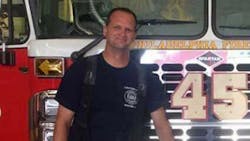Report: Cold, Poor Building Conditions Led to 2018 PA LODD
Extreme cold weather that affected the water supply and poor building conditions were some of the factors that contributed to the death of a Pennsylvania firefighter in a structural collapse while battling a blaze in an 1800s row house, according to a newly released report.
The 42-year-old lieutenant was part of the response Jan. 6, 2018, to a fire that broke out at a two-story row house when he was pinned by debris following the collapse of the building, the National Institute for Occupational Safety and Health said in its report about the fatal incident that was released Thursday. Firefighters worked for an hour to pull out the lieutenant, but he died of positional asphyxia with super heated gas and smoke inhalation, according to the report.
Although the NIOSH report doesn't identify the late firefighter or the city, the report describes the circumstances surrounding the line-of-duty death of Philadelphia Fire Lt. Matthew LeTourneau.
The NIOSH report outlined four contributing factors that led to the lieutenant's death:
- Extreme cold weather made six hydrants inoperable, diminishing the water supply
- Unique characteristics and variation of the burning row house
- Excessive clutter, an overloaded structure and deteriorated building conditions
- A risk assessment, including a structural condition evaluation, following a strategy change.
In the report, NIOSH offered four recommendations for the department to avoid a similar incident:
- Consider increasing response capabilities during extreme weather conditions.
- When a reliable, continuous water supply is cut off or unavailable and the structure's primary materials might have been subjected to severe fire conditions, firefighters should consider switching to a defensive posture.
- Firefighters should be trained to know the effect of age, use, design, construction and modifications of a building in a structural collapse and consider defensive operations when they face hoarding or dilapidated building conditions.
- When switching from a defensive to an offensive strategy, firefighters should do a thorough risk assessment that includes a structural evaluation.
Go to the National Institute for Occupational Safety and Health's website to read the full report.
